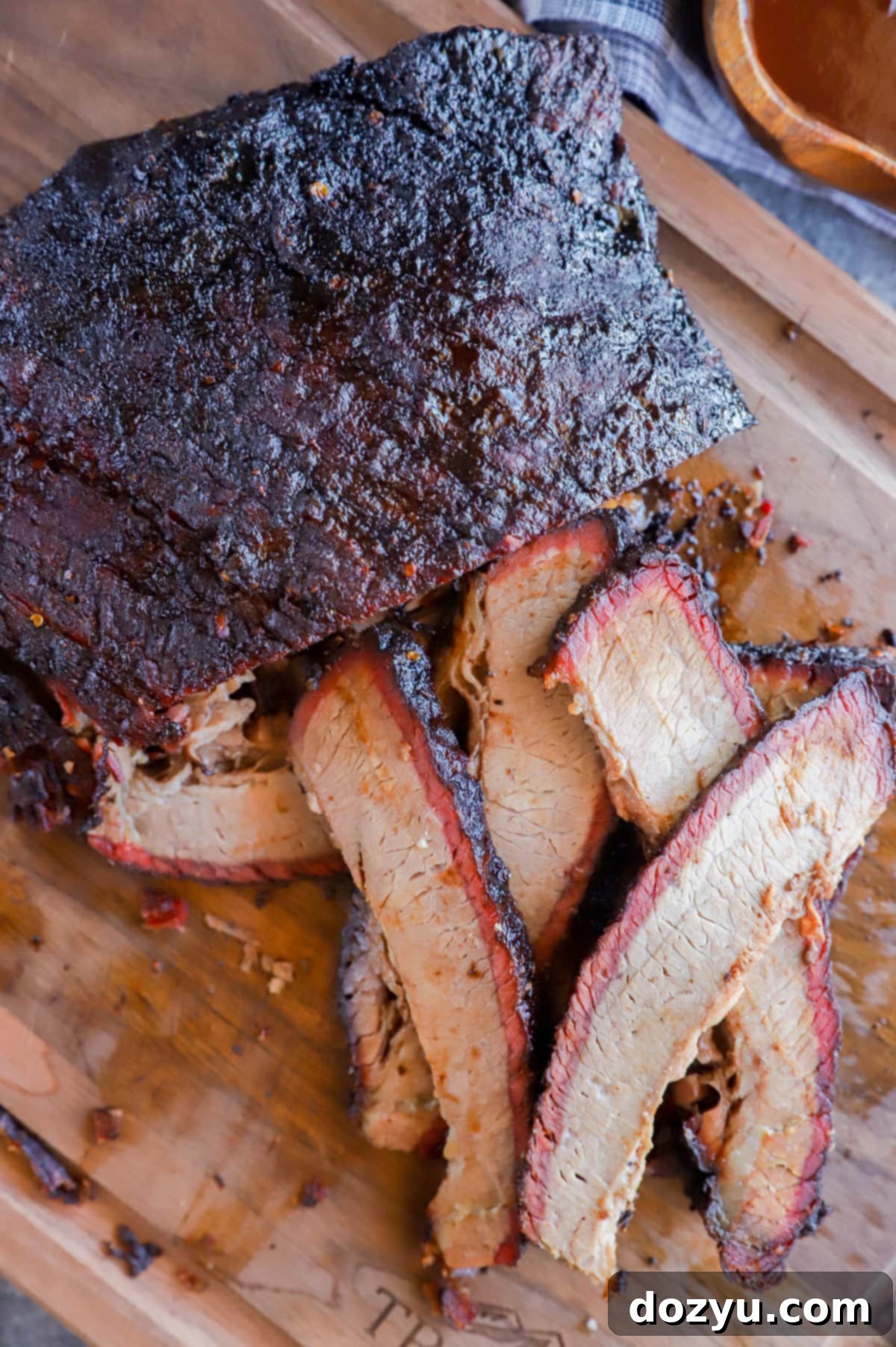Mastering Juicy Smoked Traeger Brisket: An Easy Recipe Guide for Backyard BBQ Perfection
Embark on a culinary adventure with this Easy Smoked Traeger Brisket recipe, promising a smoky, incredibly tender, and utterly delicious experience. If you’re yearning to create an epic, show-stopping meal that will captivate everyone’s taste buds, look no further – this brisket is your ultimate ticket to their hearts. With this comprehensive guide, you’ll discover that preparing this magnificent cut of meat is not just manageable, but truly enjoyable, even for beginners. Bid farewell to intimidation and say hello to your new favorite BBQ masterpiece!
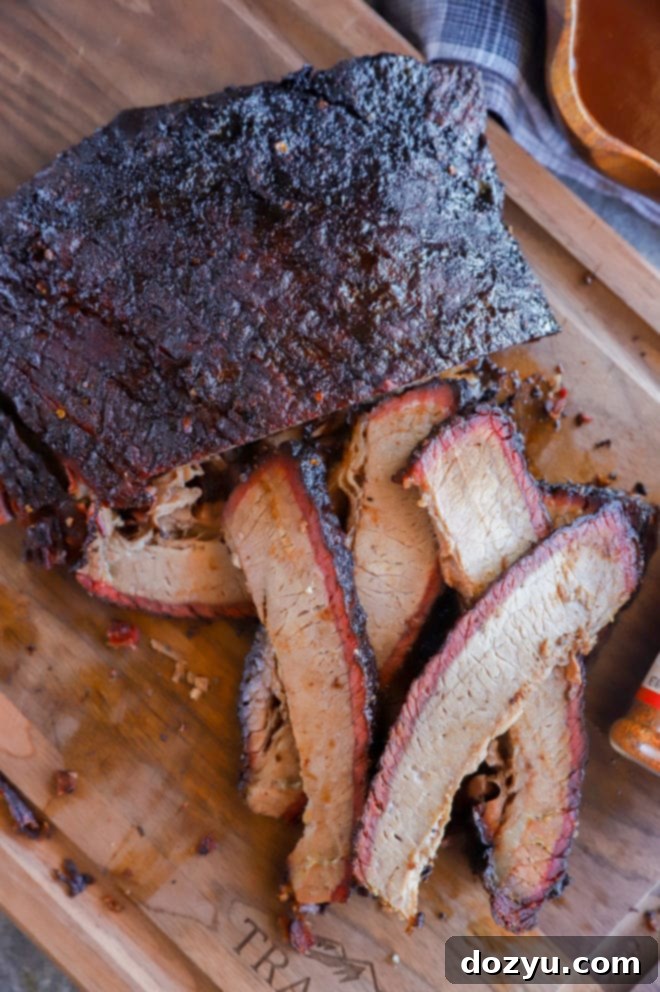
Mark your calendars! National Brisket Day falls on May 28th, and when that date aligns with a weekend, it’s a clear sign from the universe. This isn’t just an ordinary Saturday; it’s an absolute imperative to fire up your smoker and dive into the satisfying process of creating this phenomenal Traeger brisket. Imagine, a long weekend stretching ahead, offering the perfect excuse to kick back, crack open a refreshing beverage, bask in the warm sunshine on your patio, and fully immerse yourself in the leisurely pace of summer as your epic brisket slowly transforms into perfection on the grill.
While this recipe specifically highlights the Traeger grill, which I personally adore for its consistent results and distinctive wood-fired flavor, please know that any smoker you own will work wonderfully for this recipe! The core principles of low-and-slow smoking remain the same, regardless of your equipment. My enduring love for our Traeger wood pellet grill stems from its user-friendliness and the incredible smoky depth it imparts to every dish, making it a joy for both novice and experienced pitmasters alike.
table of contents
Toggle
Before You Begin: Key Details for This Traeger Brisket Recipe
- This Traeger brisket recipe focuses on a more approachable, smaller cut of brisket, typically around 6 lbs, rather than a colossal 15-pound packer. While a full packer brisket is impressive, it often yields far more meat than the average family or small gathering needs. This recipe is designed to generously feed about 6 to 8 people, making it perfectly suited for a relaxed weekend gathering, a family dinner, or a backyard BBQ without overwhelming you with leftovers (though they are delicious!). This smaller size is also more forgiving for new smokers, allowing you to master the technique without the pressure of a massive cut.
- The journey to perfectly smoked brisket demands both time and patience. Since we are embracing the art of low-and-slow smoking, the cooking process will span several hours. However, rest assured, every minute invested is profoundly rewarding. This hands-off approach makes it the quintessential weekend recipe, allowing you to kick back, relax, and savor the anticipation of a truly exceptional meal. The slow cooking method is key to breaking down the tough connective tissues in the brisket, resulting in that melt-in-your-mouth tenderness everyone craves.
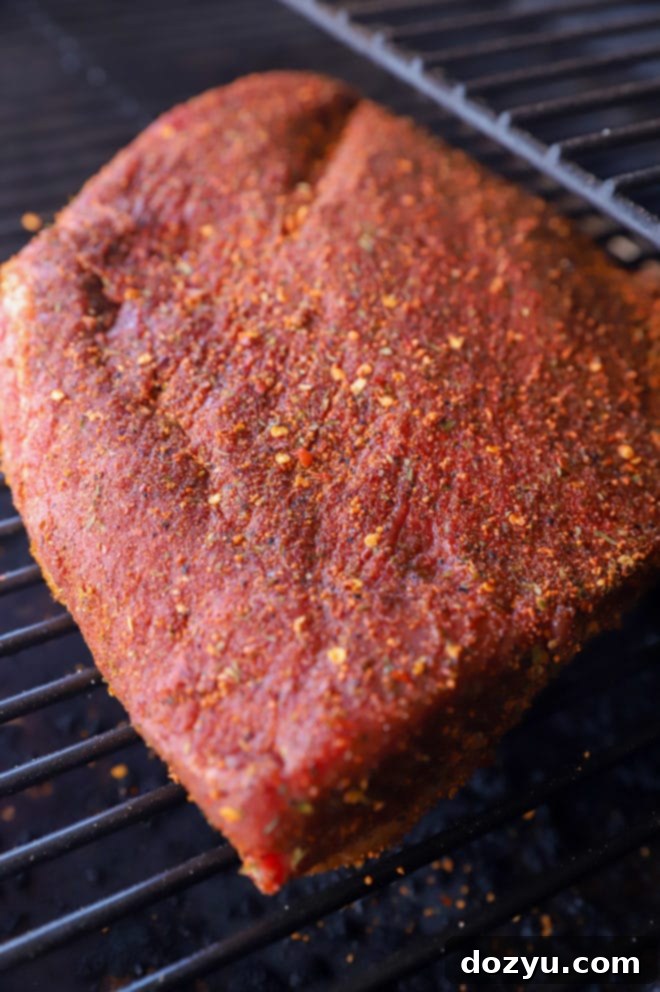
Now that we’ve clarified those important details, let’s delve deeper into what makes this smoked Traeger brisket recipe truly special. For many years, my brisket preparation was confined to the oven or a trusty slow cooker. While both of these methods certainly yield delicious results, nothing—and I mean absolutely nothing—compares to the profound smoky flavor and the irresistible crispy bark that develops on a Traeger brisket when it’s smoked meticulously, low and slow, for hours on end. The wood-fired heat of a Traeger infuses the meat with a complexity that simply cannot be replicated by other cooking techniques. It transforms the brisket into a centerpiece that’s not just a meal, but an experience.
I may not consider myself a self-proclaimed pit master, navigating the intricate nuances of competitive BBQ, but I can confidently say that this method provides the easiest and most accessible way for any beginner to master brisket. You’ll achieve incredibly tender, flavorful results with minimal fuss and a surprisingly limited number of ingredients. It’s designed to be straightforward, allowing you to focus on the enjoyment of the process rather than getting bogged down in complex steps.
Once you present this succulent, smoky brisket at your next backyard barbecue, be prepared for rave reviews. It’s truly a crowd-pleaser that will have your guests asking for your secret (which, lucky for them, you’ll be happy to share!). The rich aroma alone is enough to gather everyone around the grill, eager for their first bite.
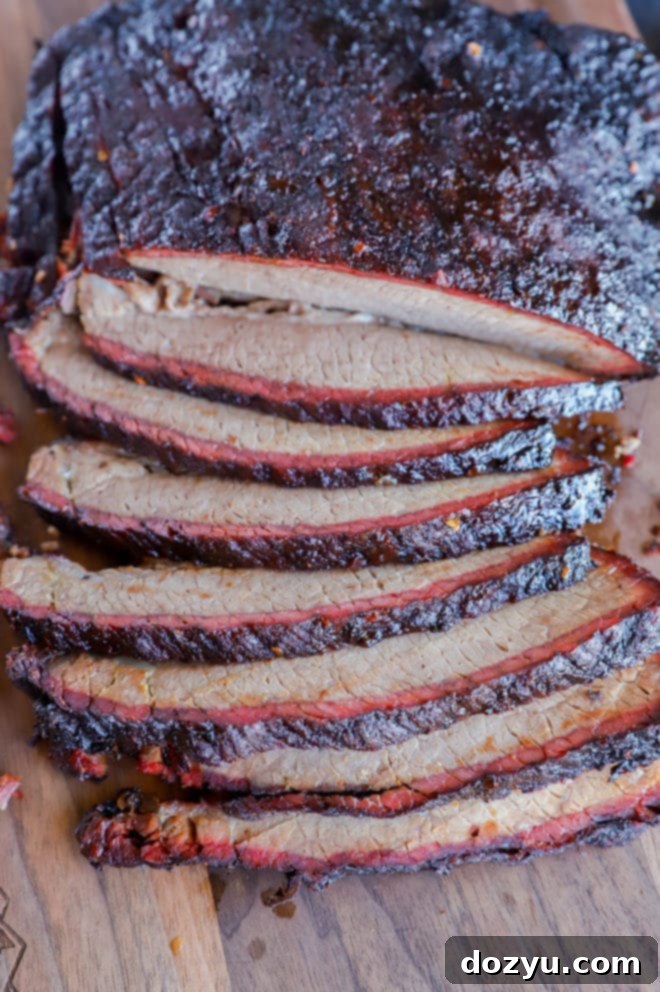
Essential Ingredients for Perfect Smoked Brisket
Crafting an unforgettable smoked brisket starts with selecting the right ingredients. Each component plays a crucial role in developing that rich flavor and melt-in-your-mouth texture.
Flat Cut Brisket – For this recipe, we specifically recommend a flat cut brisket, which constitutes the larger, leaner portion of the entire brisket. It’s characterized by its long, somewhat thinner shape with a significant, yet manageable, fat cap on one side. This particular cut is ideal for slicing, yielding beautiful, uniform pieces that are perfect for serving. In contrast, the ‘point’ cut is thicker, smaller, and contains more marbled fat, making it better suited for shredding, often used for burnt ends. Aim for a flat cut weighing approximately 6 pounds; this size is more manageable for home smokers and serves a moderate group perfectly. The quality of your meat truly makes a difference, so if possible, I highly recommend sourcing your brisket from a local butcher who can provide a high-grade cut and offer valuable advice.
BBQ Rub – Your choice of BBQ rub is paramount as it forms the flavorful crust, or ‘bark,’ on the brisket. This is where personal preference truly shines! While a simple seasoning of coarse salt and freshly ground black pepper (often called a ‘Dalmatian rub’) is a classic choice, using a prepared BBQ rub elevates the flavor profile significantly. I’m particularly fond of Head Country BBQ’s Original Championship Seasoning for its balanced sweet and savory notes. However, feel free to experiment with any brand or flavor profile you prefer – whether you lean towards spicy, sweet, or an herbal blend. Ensure you apply it generously to all surfaces of the brisket to create a robust foundation of flavor.
Beef Broth – This liquid forms the essential base for our ‘mop sauce,’ a key component in keeping the brisket moist and adding layers of flavor throughout the long smoking process. While store-bought beef broth is perfectly convenient and effective, don’t hesitate to use homemade beef broth if you have it on hand for an even richer depth of flavor.
Apple Cider Vinegar – To give the mop sauce an invigorating tang and help tenderize the meat, apple cider vinegar is my preferred choice. Its bright, acidic notes cut through the richness of the beef and complement the smoky flavors beautifully. It’s a versatile pantry staple that’s always good to have on hand for various cooking applications, especially when it comes to classic barbecue.
Worcestershire Sauce – Adding a layer of deep umami and complexity, Worcestershire sauce provides an additional savory kick to the mop sauce. Its fermented ingredients contribute a unique depth that enhances the overall flavor of the brisket. If you prefer a bit of heat, you can easily substitute or add your favorite hot sauce to the mop sauce for a spicy twist.
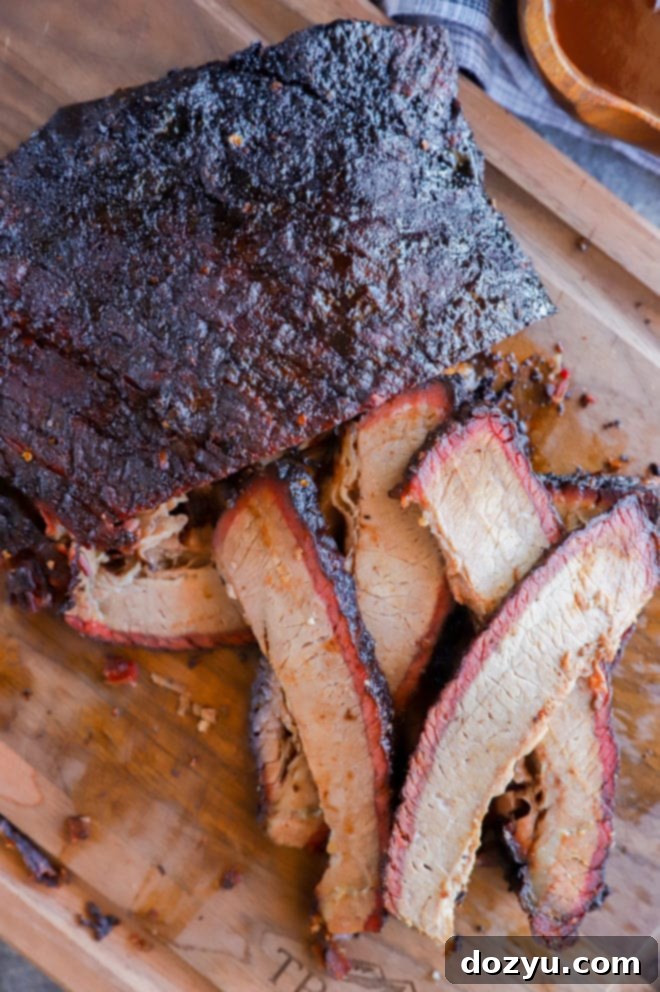
Recommended Equipment for Your Smoking Journey
Having the right tools can make all the difference in ensuring a smooth and successful brisket smoking experience. Here are the essential items that will set you up for success:
- Traeger Grill or Any Reliable Smoker: As mentioned, the star of this show is undoubtedly the Traeger grill. Its consistent temperature control and ability to produce clean, even smoke make it ideal for long cooks like brisket. I’ve personally owned my Traeger Lil Tex Elite 34 Pellet Grill for about five years now, and it continues to perform as flawlessly as the day I assembled it. If you’re using a different brand or type of smoker, just ensure you understand how to maintain a stable, low temperature for extended periods.
- Good Quality Wood Pellets: For a Traeger, your choice of wood pellets will directly impact the flavor of your smoked brisket. Hickory hardwood pellets are a classic choice for beef, imparting a strong, traditional smoky flavor that pairs wonderfully with brisket. Other excellent options include oak, pecan, or a competition blend, each offering a slightly different nuance to the smoke profile.
- Mop Brush Set with Basting Pot: A dedicated mop brush is indispensable for applying your mop sauce evenly and effectively throughout the smoking process. I highly recommend a set that comes with its own basting pot, which simplifies keeping the sauce warm and accessible right next to your smoker. This prevents contamination and ensures the sauce is ready for hourly application.
- Reliable Instant-Read Thermometer: This is arguably the most crucial piece of equipment for smoking brisket. An accurate instant-read thermometer will allow you to monitor the internal temperature of your brisket precisely, ensuring it cooks to perfection without overcooking. Don’t rely solely on estimated cooking times; temperature is your true guide to tenderness and safety.
- Large Cutting Board and Sharp Carving Knife: After hours of patient smoking, your brisket deserves to be treated with respect. A large, sturdy cutting board will provide ample space for resting and carving your masterpiece. A very sharp, long carving knife (like a butcher knife or slicing knife) is essential for cutting thin, even slices against the grain, which is key to maintaining the brisket’s tenderness.
Step-by-Step Guide: How to Make This Traeger Smoked Brisket
Follow these detailed steps to achieve a perfectly smoked, tender, and flavorful brisket that will impress everyone.
Preheat Your Smoker and Season the Meat
Begin by preheating your Traeger grill (or whichever smoker you’re using) to a precise 180˚F (approximately 82˚C). Achieving a stable temperature from the start is crucial for consistent smoking. Once your smoker reaches this target temperature, ensure the lid remains closed and allow it to preheat for at least 15 minutes. This step is vital to ensure the internal temperature of the smoker is truly stable and that you have a consistent flow of clean, thin blue smoke, which is ideal for infusing maximum flavor into the meat.
While the smoker is preheating, take your brisket and generously season it all over with your chosen BBQ rub. Don’t be shy; a good layer of rub contributes significantly to the delicious bark and overall flavor. Gently press the rub into the meat to help it adhere. Once seasoned, set the brisket aside at room temperature for a short period while the smoker finishes preheating. This allows the rub to slightly moisten and begin adhering to the meat.
Prepare the Flavorful Mop Sauce
In a small, heat-safe bowl, combine the beef broth, apple cider vinegar, and Worcestershire sauce. Stir these ingredients together until they are well blended. This will be your mop sauce, essential for keeping the brisket moist during the long cook and contributing to a delectable bark. Have your mop brush ready alongside the sauce; it will be applied regularly throughout the smoking process to enhance flavor and prevent the surface of the meat from drying out.
The Smoking Process: Low and Slow Perfection
Carefully place the seasoned brisket directly on the grill grates of your preheated smoker. Close the lid and let it smoke at 180˚F for an initial period of 3 to 4 hours. During this phase, you’ll begin applying the mop sauce approximately every hour. This regular basting helps to tenderize the exterior, build a fantastic bark, and infuse continuous moisture and flavor.
After the initial smoking period, increase the smoker’s temperature to 225˚F (approximately 107˚C). Continue cooking the brisket at this temperature, maintaining regular mop sauce applications every hour or so. The key is to monitor the internal temperature of the meat closely using an instant-read thermometer. Insert the thermometer into the thickest part of the brisket, avoiding any large pockets of fat. You are aiming for a minimum internal temperature of 190˚F (88˚C) and a maximum of 200˚F (93˚C) for optimal tenderness. This second phase of cooking will typically take an additional 4 to 5 hours, but remember, brisket cooks to tenderness, not strictly by time. The meat should feel “probe tender,” meaning the thermometer glides in and out with very little resistance, much like pushing it through warm butter.
Once your brisket reaches the desired internal temperature and tenderness, carefully remove it from the grill. Transfer it to a large cutting board or a rimmed baking sheet. The next crucial step is resting: cover the brisket loosely with aluminum foil and allow it to rest for at least 30 minutes, with a full hour being ideal. This resting period allows the muscle fibers to relax and reabsorb the juices, ensuring a supremely moist and tender brisket. Skipping this step can result in dry, tough meat. When it’s time to serve, slice the brisket against the grain – this is vital for tenderness – and present it with your favorite BBQ sauce on the side for an added burst of flavor.
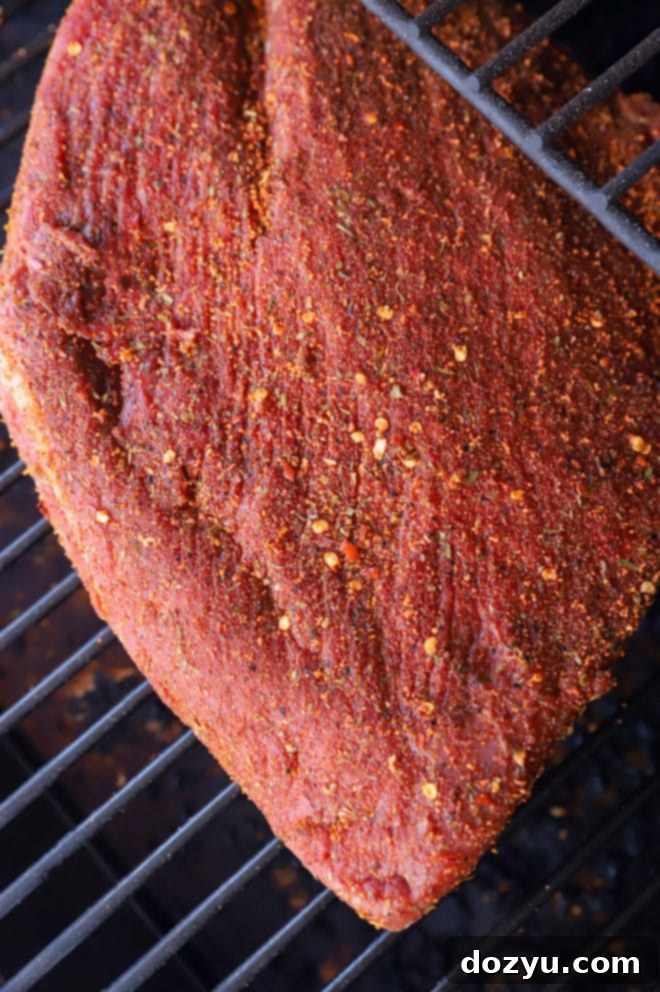
Expert Tips for Brisket Smoking Success
Achieving legendary smoked brisket goes beyond just following the steps; a few key practices can elevate your results from good to unforgettable:
Don’t Forget to Rest Your Brisket. This step is critically important and often underestimated. After removing your brisket from the smoker, resist the urge to slice into it immediately. Resting allows the internal temperature to equalize and, more importantly, permits the juices that have been pushed to the center of the meat during cooking to redistribute throughout the muscle fibers. Without proper resting, these precious juices will simply run out onto your cutting board, leaving you with dry meat. Aim for at least 30 minutes of rest, but a full hour (or even two for larger briskets, wrapped in butcher paper and placed in a cooler) is truly best for maximizing tenderness and juiciness.
Maximize Those Leftovers. It’s highly probable you’ll have some delicious smoked brisket leftover from this Traeger brisket recipe, and that’s a good thing! Smoked brisket is incredibly versatile. Beyond simply reheating it, I love transforming leftovers into new culinary delights. Consider crafting a hearty BBQ charcuterie board with sliced brisket, cheeses, pickles, and crackers, or using it to make an incredible sandwich, like a smoky reuben or a loaded brisket grilled cheese. Brisket tacos, quesadillas, or even a rich brisket chili are also fantastic ways to enjoy every last bit.
Always Slice Against the Grain. This is a fundamental rule for serving tender brisket. Brisket has very distinct muscle fibers (the “grain”). If you slice with the grain, the slices will be stringy and tough, no matter how perfectly cooked the meat is. By slicing directly against the grain, you shorten these muscle fibers, making each bite incredibly tender and easy to chew. Take a moment to identify the direction of the grain before you start carving, as it can sometimes change in different parts of the flat.
Monitor the Stall. During long smokes, brisket often experiences a phenomenon called “the stall,” where its internal temperature plateaus for several hours, typically between 150-170°F (65-77°C). Don’t panic! This is normal and happens as moisture evaporates from the surface, cooling the meat. Resist the urge to increase your smoker’s temperature drastically. Patience is key here; the stall will eventually break. If you wish to power through it, you could consider wrapping the brisket in butcher paper or foil once it hits the stall, though for this recipe, the mop sauce helps manage this without needing to wrap.
Choose Your Wood Wisely. The type of wood pellets you use will impart distinct flavor profiles. For beef brisket, robust woods like hickory, oak, or mesquite are traditional and highly recommended, providing a deep, rich smokiness. Pecan offers a slightly milder, sweeter smoke, which is also a popular choice. Avoid very light woods like alder for brisket, as their flavor might get lost, or excessively strong ones like pure mesquite if you prefer a less intense smoke.
More classic bbq recipes to explore: Honey BBQ Grilled Chicken Wings | BBQ Apple Cider Ribs | Gourmet BBQ Burger Bar | Grilled Chipotle BBQ Chicken Skewers
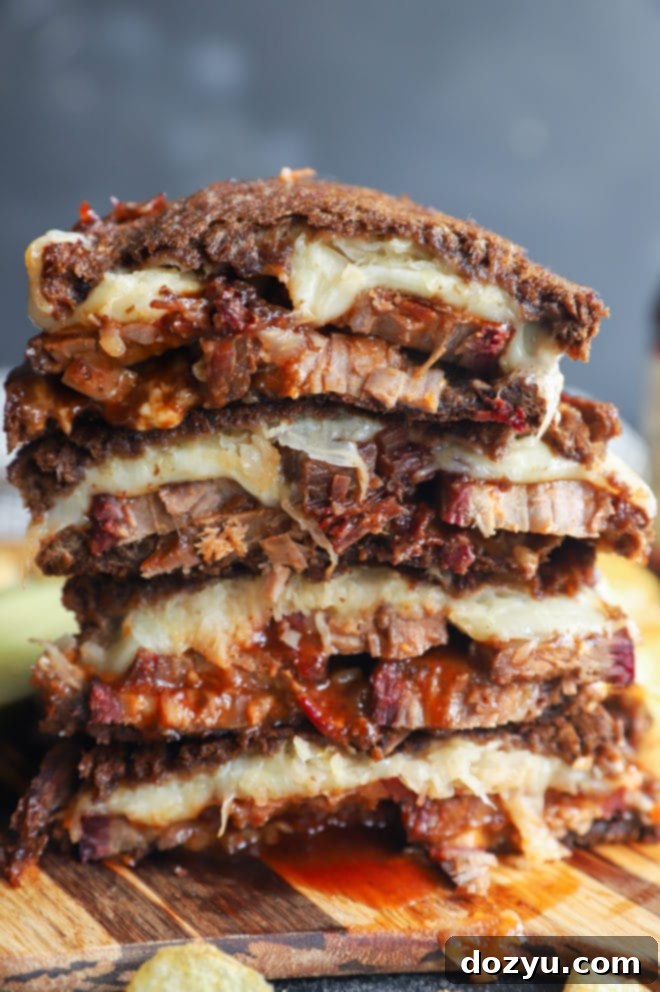
What Exactly is a Mop Sauce?
A mop sauce, also sometimes referred to as a basting liquid, is a thin, usually vinegar-based sauce that is periodically brushed or “mopped” onto meat during the long smoking or grilling process. Its primary function is multifaceted: it helps keep your meat tender and moist by rehydrating the surface, preventing it from drying out over extended cooking times. Furthermore, it contributes significant layers of flavor, penetrating the bark and infusing the outer layers of the meat with additional zest and savoriness. Our recipe’s mop sauce is a wonderfully simple yet effective three-ingredient blend made from common pantry staples – beef broth, apple cider vinegar, and Worcestershire sauce. Beyond moisture and flavor, applying a mop sauce encourages the formation of that highly desirable crunchy, flavorful bark on the exterior of the brisket, which locks in the internal moisture and provides a delightful textural contrast.
Should You Wrap Your Traeger Beef Brisket?
The decision to wrap or not to wrap brisket (often called the “Texas Crutch”) is a common debate among pitmasters. For this particular recipe, because we are regularly applying a mop sauce, there’s no explicit need to wrap the brisket in butcher paper or foil during the smoking process. The mop sauce effectively helps maintain moisture and build the bark. However, if you opt to skip the mop sauce, or if you encounter a stubborn “stall” where your brisket’s temperature plateaus for an extended period, wrapping can be a beneficial technique. Wrapping in butcher paper allows some smoke to still penetrate while creating a steamy environment that pushes the meat through the stall and tenderizes it. Aluminum foil, on the other hand, creates a tighter seal, which can tenderize even faster but might slightly soften your bark. Ultimately, the choice is yours and can be adjusted based on your preference for bark texture and how quickly you want to finish the cook.
Smoking Brisket: Fat Side Up or Down?
This is another classic topic that sparks friendly (and sometimes not-so-friendly) debates in the BBQ community! Both methods – smoking brisket fat side up or fat side down – work perfectly fine, and in my personal experience, I haven’t observed a significant difference in the final outcome. (Please, seasoned pitmasters, don’t send angry emails!). Some argue that fat side up allows the melting fat to baste the meat below, keeping it moist. Others contend that fat side down protects the leaner flat from the direct heat of the smoker, which often comes from below. For this specific brisket you see pictured in the photos, I placed it fat side down, just to offer a definitive choice if you’re struggling to make up your mind. The most important thing is consistent temperature and proper internal doneness, not necessarily the orientation of the fat cap.
Unveiling the Mysterious Smoke Ring
That distinctive pinkish hue you often see just beneath the bark, around the edge of perfectly smoked meat, is called the smoke ring! It’s a hallmark of true barbecue and a visual testament to successful low-and-slow smoking. Scientifically, it’s formed when gases from the wood smoke, primarily nitric oxide and carbon monoxide, react with the myoglobin (the protein responsible for meat’s red color) in the meat. This chemical reaction “fixes” the pink color, preventing it from turning brown under heat. While the smoke ring doesn’t inherently add flavor, it is highly prized for its aesthetic appeal and signifies that the meat has been exposed to true wood smoke over an extended period. The key to achieving a prominent smoke ring is cooking at lower temperatures (like 180-225°F) for a longer duration, allowing these reactions to occur before the myoglobin completely breaks down from high heat.
Ideal Internal Temperature for Perfectly Cooked Brisket
Determining when brisket is “done” isn’t solely about hitting a specific temperature, but it’s a critical indicator. When your brisket reaches an internal temperature of around 195˚F (91˚C), it is generally considered properly smoked and nearing peak tenderness. The minimum temperature for safe consumption of brisket, where connective tissues begin to break down into gelatin, is around 190˚F (88˚C). Many experienced pitmasters aim for a slightly higher range, often between 202˚F to 205˚F (94˚C to 96˚C), as this is where the meat usually becomes “probe tender” – meaning an instant-read thermometer or skewer slides into the meat with virtually no resistance. In my experience, removing the brisket from the smoker once it hits 195˚F allows for a phenomenon called “carry-over cooking.” During the resting period, the internal temperature will continue to rise by a few degrees, often bringing it perfectly into that ideal 202-205˚F range. Crucially, do not let the internal temperature exceed 210˚F (99˚C), as going too high can lead to moisture loss, resulting in a dry, less palatable brisket.
Adapting This Recipe for Charcoal or Stick Burner Smokers
Absolutely! This recipe can certainly be adapted for use with a charcoal smoker (like a Weber Smokey Mountain) or a traditional stick burner. The core principles of low-and-slow smoking, seasoning, and mopping remain the same. However, there are a few important considerations. With a traditional charcoal or stick burner smoker, maintaining a consistent, stable temperature (especially the initial 180˚F, then 225˚F) requires a more hands-on approach compared to the set-and-forget convenience of a pellet grill like a Traeger. You’ll need to actively monitor and adjust vents, and manage your fuel (charcoal and wood chunks for a charcoal smoker, or logs for a stick burner) more frequently. This constant vigilance might result in a longer overall cooking time than the estimate provided in this recipe, as temperature fluctuations can slow the cooking process. Ensure you have a reliable dual-probe thermometer to monitor both the smoker’s ambient temperature and the brisket’s internal temperature simultaneously. A water pan is also highly recommended in these types of smokers to help stabilize temperature and add moisture to the cooking environment.
To Brine or Not to Brine Your Brisket?
While I didn’t opt to brine my brisket for this particular recipe, the decision to brine yours is entirely up to personal preference and the flavor profile you’re aiming for. Brining involves soaking meat in a solution of salt, sugar, and various aromatics. For brisket, a brine can help enhance moisture retention, making the final product even juicier, and can also infuse additional flavors deep into the meat. If you choose to brine, ensure it’s for an appropriate duration (typically 12-24 hours for a brisket of this size) to avoid over-salting, and adjust your external rub application accordingly to prevent it from becoming too salty. Many believe a good rub and proper smoking technique are sufficient for brisket, but if you’re looking for an extra layer of moisture and seasoning, brining can be a worthwhile experiment.
Need some more inspiration for meaty mains? Check out my meat main recipes page!
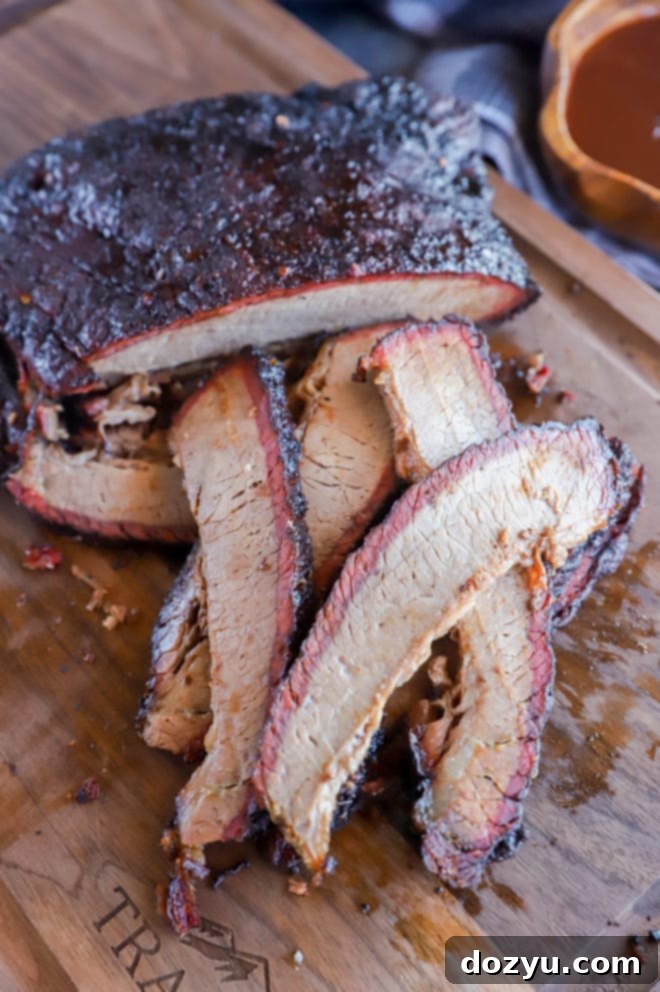
Delicious Pairings: What to Serve with Easy Smoked Traeger Brisket
Since this exquisite Traeger brisket is destined to be the star of your gathering, let’s craft the ultimate menu to perfectly complement this gorgeous slab of smoky meat!
- For an irresistible appetizer, you can start with something wonderfully gooey and cheesy, like this delightful spinach artichoke goat cheese dip. Its creamy texture and savory flavors are an excellent way to whet appetites. Alternatively, for a lighter, summery option that’s perfect for barbecues, try this vibrant tomato peach bruschetta – it’s a snap to whip up and offers a refreshing burst of seasonal flavors.
- When it comes to side dishes, I’m always keen on modern and flavorful takes on classic barbecue accompaniments. The rich, smoky profile of brisket pairs beautifully with a variety of textures and tastes. Consider loaded bacon potato skewers for a hearty and fun side, or a refreshing summer lemon pasta salad, which offers a bright, tangy contrast to the brisket. For a crunchy potato side dish that’s surprisingly easy to make and boasts incredible crispiness, these oven fried potatoes and onions are a must-try. And if you’re looking to capitalize on the abundance of fresh summer corn, this flavorful masala corn salad will add an exciting, spiced dimension to your meal.
- To perfectly wash it all down, prepare a big batch of a refreshing beverage. A zesty vodka strawberry lemonade or some vibrant limeade margaritas are fantastic choices, offering a cool and invigorating counterpoint to the rich flavors of the brisket and sides.
If you’ve fallen in love with all things Traeger, be sure to expand your grilling repertoire! Explore these fantastic Traeger chicken wings recipes for another crowd-pleasing option, or try your hand at this succulent smoked pork loin for a different, equally delicious smoked main course!
Storing Your Smoked Brisket: Tips for Freshness and Reheating
Proper storage ensures you can enjoy your delicious smoked brisket for days to come, and reheating it correctly is key to maintaining its tenderness and flavor.
Store. To keep leftover brisket fresh, allow it to cool completely before transferring it to an airtight container. Store the container in the refrigerator for up to 4 days. For best results, slice only what you plan to eat immediately, keeping larger pieces intact for storage.
Reheat. To reheat sliced brisket without drying it out, wrap the desired portion loosely but securely in aluminum foil. Place the foil-wrapped brisket in a baking dish or on a rimmed baking sheet. Warm it in a preheated 300˚F (150˚C) oven for about 15 to 20 minutes, or until it is thoroughly warmed through. A splash of beef broth inside the foil before reheating can also help keep it moist.
Freeze. For longer storage, brisket freezes exceptionally well. Once cooled, slice the brisket or divide it into meal-sized portions. Place the portions in a heavy-duty resealable freezer bag, removing as much air as possible to prevent freezer burn. You can also vacuum seal it for even better preservation. Properly frozen brisket can be stored for up to 3 months.
Thaw. To thaw frozen brisket leftovers, simply transfer the sealed bag or container to a plate in the refrigerator and let it thaw overnight. Once thawed, reheat as instructed above for best results.
Finally, if you take the time to make this incredible Traeger brisket recipe, please be sure to give this recipe a rating and/or leave a comment below! Your feedback is incredibly valuable, and I genuinely love hearing about your cooking experiences. I make it a point to respond to every single comment, so don’t hesitate to share your thoughts or ask any questions you might have.
Oh, and for an extra special treat, be sure to tag me on Instagram if you make the recipe! It brings me so much joy to see these recipes come to life in your homes – scrolling through those photos is truly my favorite thing. It means the world to me!
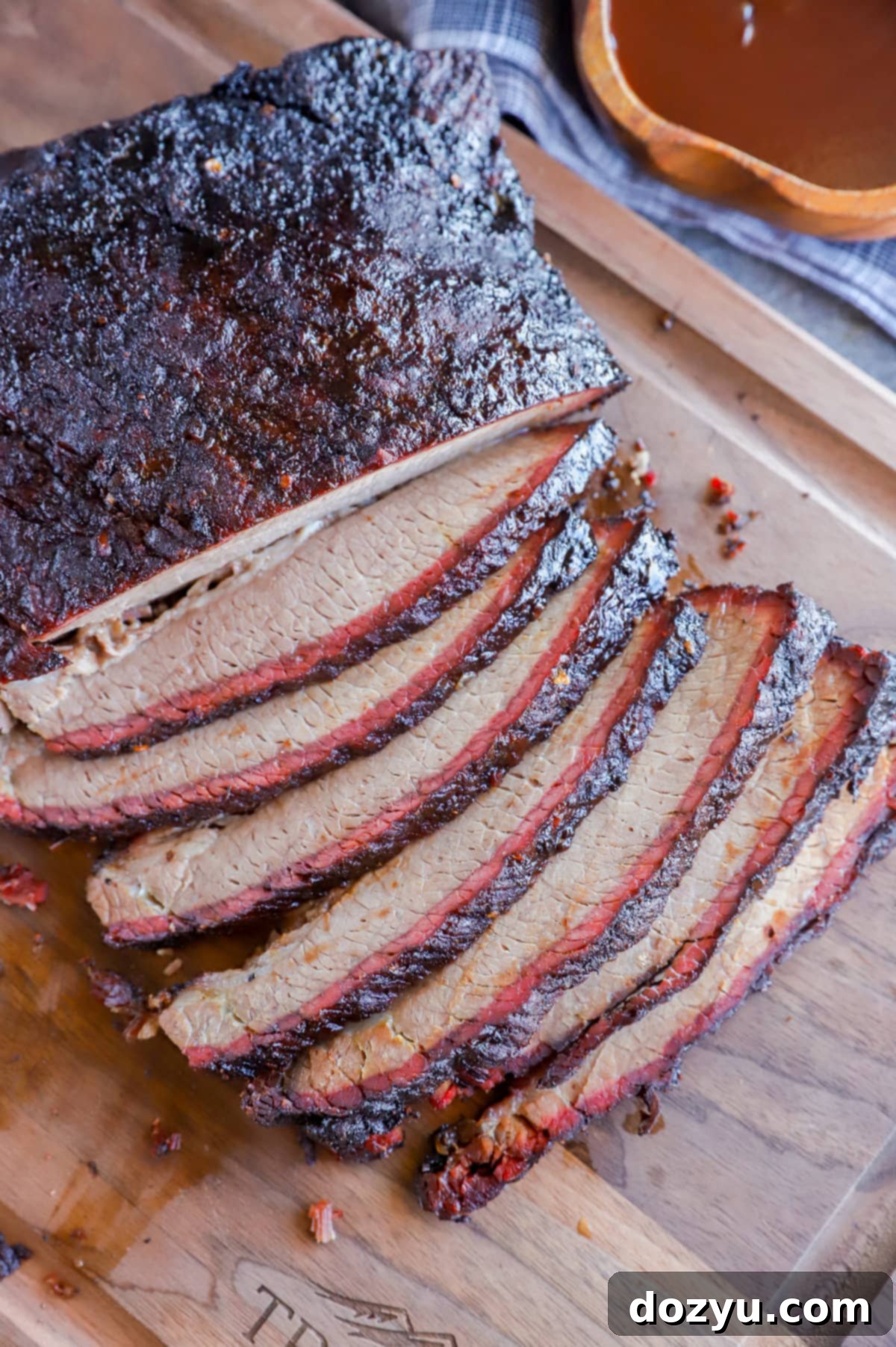
Easy Smoked Traeger Brisket
equipment
-
Cast Iron Basting Pot and Brush
-
Traeger Lil Tex Elite 34 Pellet Grill
-
Hickory Hardwood Grill Pellets
-
9-Inch Tongs
-
Utility Cutting Board
-
Wusthof 8″ Artisan Butcher Knife, Hollow Edge
ingredients
- 1 6 lb flat cut brisket, trimmed
- 1/4 cup your favorite BBQ rub I like to use Head Country Championship or High Plains Heat Seasoning
- 2 cups beef broth
- 1/3 cup apple cider vinegar
- 1 Tbsp Worcestershire sauce
- Serving: your favorite BBQ sauce
instructions
-
Preheat Traeger grill (or smoker of your preference) to 180˚F. Once preheated, make sure to let it sit, lid closed, for 15 minutes before adding the meat.
-
Season the brisket all over with BBQ rub.
-
In a small bowl, stir together beef broth, apple cider vinegar, and Worcestershire sauce for the mop sauce. Set aside.
-
Place the brisket on the grill and smoke for 3 hours, applying mop sauce with mop brush every hour.
-
Increase temperature to 225˚F and continue to cooking, applying mop sauce every hour or so. Once an instant-read meat thermometer reads 204˚F when inserted into the thickest part, remove from grill and wrap in foil.
-
Let rest for at least 30 minutes to 1 hour.
-
When ready to serve, slice against the grain and serve with your favorite BBQ sauce.
